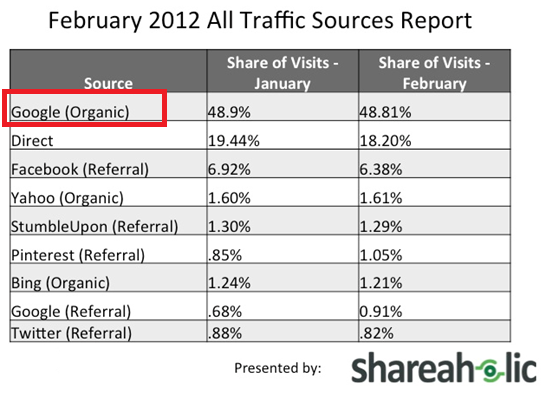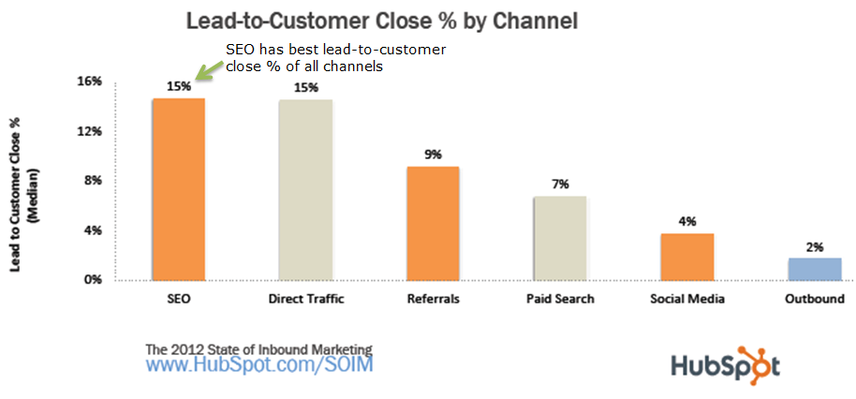Organic Search Leads Traffic and Conversions Yet Trails in Budgets and Mindshare
- Thought Leadership
- By Seth Besmertnik
- 5 minutes read
Organic search is not be the inbound channel that gets the most attention, but the latest Hubspot data shows it remains the best driver of inbound web traffic.
If a Marketer from Mars landed on Earth today, read through the last 12 months of tech news, and was asked to come to a conclusion about the largest drivers of inbound traffic to web sites based on the frequency of coverage, his answer would probably contain the words ‘Pinterest’, ‘Twitter’, and ‘Facebook’—organic search would not even be on his radar.
However, marketers are not from Mars, and are supposed to care about ‘data’. They are highly familiar with the statistics that point to search's place at the top of the purchase funnel such as Marketing Sherpa that states 81% of online adults use search engines to research Products. So why has the media been so successful in distracting Marketers from the data-driven, core marketing tactics that drive the lion's share of traffic?
Organic Search Drives 5x More Traffic Than All Social Combined
An overwhelming example of this is a recent TechCrunch article covering a Shareaholic study on the growth rates of Pinterest, ‘Pinterest Overtakes Twitter on Referring Traffic ’. Reading the headline of the post, you may be left thinking you need to shift serious online marketing effort to Pinterest. I have no doubt many marketers forwarded this to their teams asking, “should we be doing more on Pinterest?"
Organic search is not be the inbound channel that gets the most ink in media coverage, but the latest data with a non-trivial sample size tells us it remains, by far, the largest driver of inbound web traffic. Organic search is also the best channel for converting customers; it has the best lead-to-customer close percentage of all inbound channels.
What was not mentioned, however, was the glaring discrepancy between the traffic Pinterest is driving, even at its current growth rates, and what tried-and-true channels such as organic search continue to generate (see chart below). Using a sample size of 270 million visits, Pinterest is now 1.05% of all visits, beating Twitter at less than 1% (.82%) of all visits. Google organic traffic is nearly half (48.81%) of all visits—almost 50x Pinterest’s traffic and 5x more than all social sites combined. In our example, the Marketing VP wants to know when his team is going to ramp up their Pinterest strategy. Yet, he probably does not have a comprehensive SEO strategy, has not spent a lot of time thinking about how his company can build a competency in SEO, and is working himself into a lather about the less-than-1% of Pinterest traffic potential. It seems short sided to focus on the latest hype when a major opportunity is in front of us and by fracturing our focus, we put our core channels at risk (remember when marketers were going crazy over URL shorteners ?)
I do not want to discredit putting effort into Pinterest as a new source of customer acquisition and influence—but suggest marketers look at the data and be formulaic about determining their strategic priorities.
One way of examining your priorities is to build a formula that looks at:
- Size of the Opportunity: How much potential is there, and what is your current penetration rate against this opportunity
- Risk: If you do nothing, what will you lose, what will you gain?
- Execution Viability: How much will it cost you (cost can be a measure of dollars, political dollars, engineering resources, etc) to execute against the opportunity?
Going after the organic search opportunity is not an easy challenge and is likely the reason why a majority of major brands are barely reaching their potential. Unlike other channels such as paid search, SEO requires a holistic approach to marketing where people must collaborate and work together, something that becomes increasingly difficult the larger you are, especially across departments. This is exactly why we started Conductor, to make this easier and more tangible. But it’s still no doubt difficult.

Let’s take a look at some the numbers to help you with your business case for SEO.
SEO Has the Best Lead-to-Customer Rate of All Inbound Marketing Channels
It may not be surprising for longtime online marketers to be reminded that Google organic search is the largest driver of online traffic. However, being the biggest driver of traffic is not enough for us to draw conclusions about its value relative to other channels as a driver of leads. Marketers also want conversions. A recent Hubspot study shows the highest percentage of leads end up as customers from SEO, a higher conversion percentage than both paid search and social media.

SEO Becomes Increasingly Important to Marketers As a Conversion Generator
When we dive deeper into the Hubspot study and look at trends of how Marketers view their Marketing channels, more than half say SEO has become increasingly important as a source of leads over the last six months. Interestingly, fully one quarter of respondents state PPC has become less important to them over the last six months. This may be because it is moving closer to being on auto-pilot versus something they can throw more strategy at to make a huge impact.

Organic Search Not Hot New Thing, But Biggest Driver, Best Converting of All Channels
Organic search is not the inbound channel that gets the most ink in media coverage, but the latest data with a non-trivial sample size tells us it remains, by far, the largest driver of inbound web traffic. Organic search is also the best channel for converting customers. It has the best lead-to-customer close percentage of all inbound channels.
There is little question that there is value for online marketers in leveraging hot trends that have the potential to drive traffic and create buzz for their online property. But acquisition marketing is supposed to be data-driven, not hype-driven; for many Marketers in the trenches this might mean continuously pulling out data like the above when an excited executive wants to divert substantial resources and budget to the latest new thing.
Data is not just for campaign optimization. Use it to set your priorities.

![Seth Besmertnik, CEO and Co-Founder, [object Object]](https://cdn.sanity.io/images/tkl0o0xu/production/79e6eda2a43959d9ac71253ccff188677b8260d8-3542x3542.png?fit=min&w=100&h=100&dpr=1&q=95)





